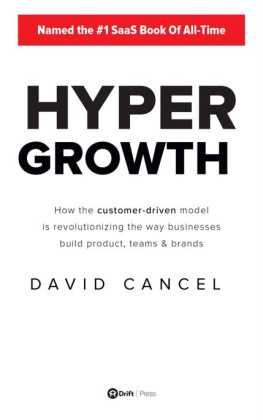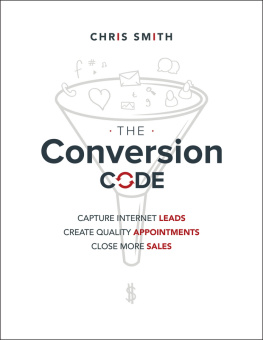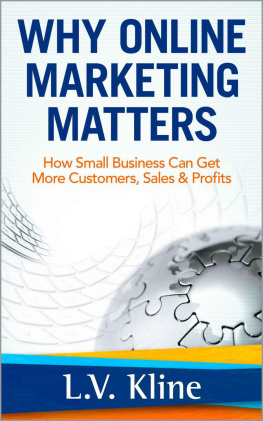
Cover design: Wiley
Copyright 2019 by Drift.com, Inc. All rights reserved.
Published by John Wiley & Sons, Inc., Hoboken, New Jersey.
Published simultaneously in Canada.
No part of this publication may be reproduced, stored in a retrieval system, or transmitted in any form or by any means, electronic, mechanical, photocopying, recording, scanning, or otherwise, except as permitted under Section 107 or 108 of the 1976 United States Copyright Act, without either the prior written permission of the Publisher, or authorization through payment of the appropriate per-copy fee to the Copyright Clearance Center, Inc., 222 Rosewood Drive, Danvers, MA 01923, (978) 7508400, fax (978) 6468600, or on the Web at www.copyright.com. Requests to the Publisher for permission should be addressed to the Permissions Department, John Wiley & Sons, Inc., 111 River Street, Hoboken, NJ 07030, (201) 7486011, fax (201) 7486008, or online at http://www.wiley.com/go/permissions.
Limit of Liability/Disclaimer of Warranty: While the publisher and author have used their best efforts in preparing this book, they make no representations or warranties with respect to the accuracy or completeness of the contents of this book and specifically disclaim any implied warranties of merchantability or fitness for a particular purpose. No warranty may be created or extended by sales representatives or written sales materials. The advice and strategies contained herein may not be suitable for your situation. You should consult with a professional where appropriate. Neither the publisher nor author shall be liable for any loss of profit or any other commercial damages, including but not limited to special, incidental, consequential, or other damages.
For general information on our other products and services or for technical support, please contact our Customer Care Department within the United States at (800) 7622974, outside the United States at (317) 5723993 or fax (317) 5724002.
Wiley publishes in a variety of print and electronic formats and by print-on-demand. Some material included with standard print versions of this book may not be included in e-books or in print-on-demand. If this book refers to media such as a CD or DVD that is not included in the version you purchased, you may download this material at http://booksupport.wiley.com. For more information about Wiley products, visit www.wiley.com.
Library of Congress Cataloging-in-Publication Data has been applied for and is on file with the Library of Congress.
ISBN 9781119541837 (Hardcover)
ISBN 9781119541868 (ePDF)
ISBN 9781119541899 (ePub)
Introduction: The Shift from Supply to Demand
Think about the way you buy products and services today compared to just 10 or 20 years ago. Whether you are buying a book (like this one), or renting a movie, or finding a ride to the airport, the buying experience has undergone a total transformation.
Today, instead of being forced to buy at a place and time that is convenient for the company, you can now buy just about anything from the comfort of your own home, or from your office, or from just about anywhere (provided you have an internet connection). And best of all, you can buy in real time or whenever is most convenient for you, the customer.
Today, Customers Have All the Power
Want to rewatch your favorite movie? Just a few years ago, that meant trudging to a video rental store and waiting in line so you could rent a DVD or VHS tape. Today, with just a few clicks, you can watch all of your favorite movies and TV shows on-demandno waiting in line.
Ready to catch that ride to the airport? Just a few years ago, that meant walking to a cab stand, or trying to hail a cab from the sidewalk (not as easy as it sounds), or calling a cab company the day before, being put on hold, having to call back in the morning, and then never knowing for sure whether someone would show up. Today, you can schedule a ride on your phone with the push of a button and have it arrive at your door in a few minutes. (And you can track your drivers progress on a map inside the app so you know exactly when youll be picked up.)
In this real-time, on-demand world we now live in, where access to an endless supply of products and services is always just a few clicks away, the marketers and salespeople vying for our business need to come to terms with a new, fundamental truth: The balance of power has shifted.
Today, customers have all the power. And the companies that end up winning in this new world will no longer be the ones that own the supply, but the ones that own the demand. Here are three key factors that led to this monumental shift.
1. Product Information Became Free
Gone are the days when companies could keep information about their products and services locked up and hidden away from their potential customers. Today, thanks to search engines, review websites, and social media recommendations, customers no longer need to rely on marketers or salespeople in order to educate themselves and make informed purchase decisions.
Instead of simply taking a companys word for it that their product or service is worth the price, or can solve a particular problem, todays buyers can consult a wide variety of resources and opinions in order to paint a fuller picture of what to expect from their purchase. And, of course, todays buyers arent just researching and evaluating the potential benefits of the actual products; they are also evaluating the companies themselves and the level of service they provide, which leads me to factor number two:
2. Real-Time Interactions Became Expected
The second reason why customers have all of the power today: because real-time interactions have become the default. Today, billions of people around the world use real-time messaging for their day-to-day communication. More and more of us are chatting with our friends and family on messaging apps like WhatsApp, and at work we are chatting with our coworkers via messaging-powered collaboration tools like Slack.
As a result of this shift in how we communicate, coupled with the fact that we can now order so many products and services on-demand with just a few clicks, our customer expectations have evolved. We have become conditioned to expect real-time responses when we have questions and to expect instant solutions when we have problems.
3. Supply Became Infinite
Regardless of the product or service you are in the market for, today there are usually at least a handful of options you can choose from as a buyer. And in many cases, there are dozens of competitors all fighting for your dollars. (Just go to any supermarket and count how many different potato chip brands you see on the shelves.) As customers, that means we have more choice and can be more selective. As marketers and salespeople, it means that we can no longer expect our companies to win in a certain category just by showing up with our producteven if its a good product. Owning the supply isnt enough.
Just look at the razor company Gillette, which dominated the razor industry for more than a century. Gillettes success stemmed from owning the design of their patented safety razor, owning the distribution centers for getting their razors out to retailers, and owning the relationships with those retailers. In other words, Gillette owned the supply. And for decades, if you wanted to buy a razor, you had no choice but to go to a brick-and-mortar retailer, like CVS or Walgreens, where you would inevitably find Gillette razors for sale on the shelves.
Then, in 2011, Dollar Shave Club appeared on the scene and turned Gillettes supply-driven model on its head. Instead of going head-to-head with Gillette and competing for shelf space, which was the approach competitors like Schick and BIC had taken, Dollar Shave Club went around the retailers and began selling their razors directly to consumers. To generate buzz for the new service, they crafted memorable marketing campaigns that stressed how expensive the razors in the stores were, how much of a pain it was to remember to buy them, and how all of the new features the supply-focused razor companies were adding to their products (like vibrating handles) were worthless. Then Dollar Shave Club presented their subscription service, which offered premium (but no-frills) blades at a lower price, as the solution.
Next page









